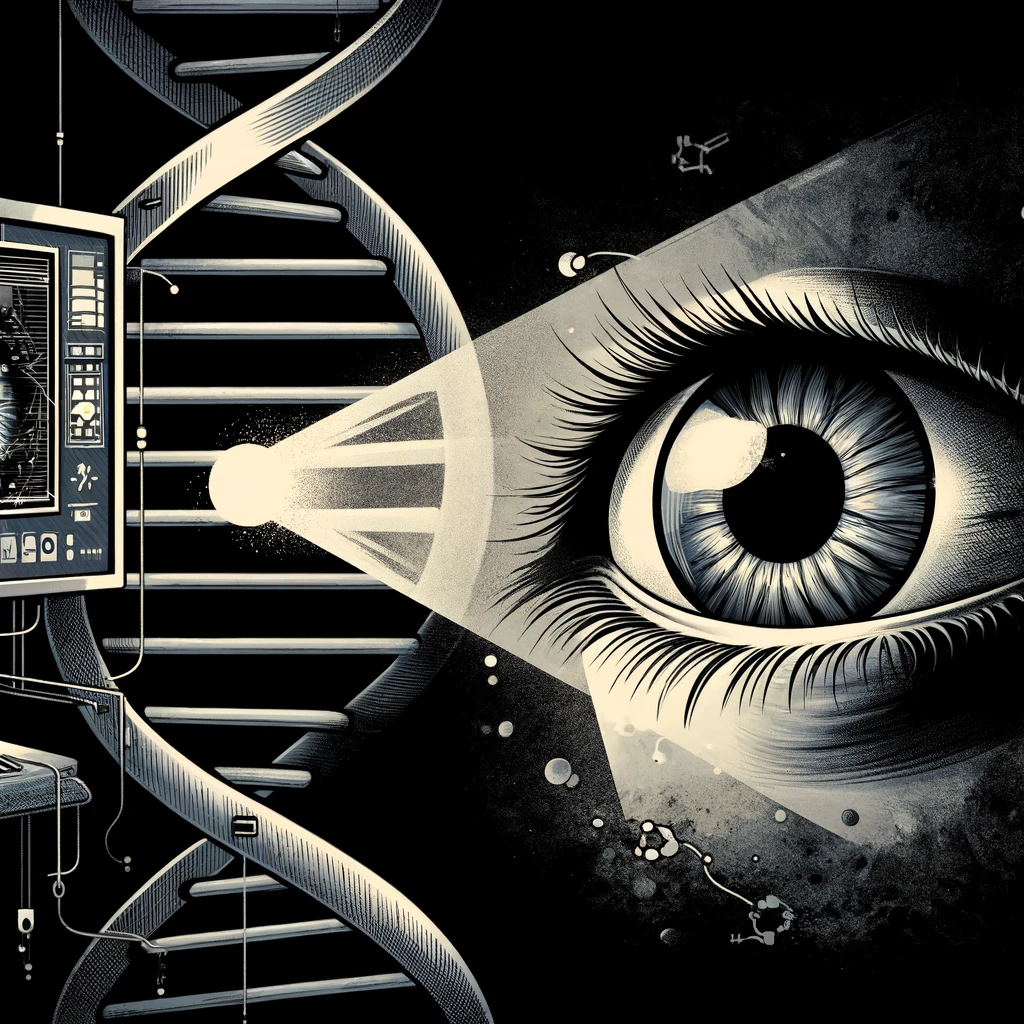Prolog
Imagine a scene in the not-so-distant future. Someone has been murdered. Two investigation teams arrive at the scene, but it is unclear who has jurisdiction. The human team is led by the charismatic detective Sheerluck Holmes, while the android team is led by Bot-OX. The question is: Is the perpetrator human, android, or something in between? Should we expect that the police of the future have established a well-defined procedure or algorithm to decide this quickly?
We will try to answer this and the more pressing issue we are currently facing: Do we have a good chance of coming up with an algorithm that is practical and allows us, by only looking at the crime scene (the generated text), to decide whether a bot or a human created it? Developing such an algorithm is currently one of the most sought-after goals in computer science. A robust Blackbox Algorithm could save most of our academic conventions and allow us to maintain the ways we test children, adolescents, and adults. Without it, these systems will need to be rebuilt at great expense.
In a world where more and more people work and train remotely, it is crucial that we can reliably determine that humans did their intellectual work themselves, which is not the case at the moment. Additionally, with the reach of social media, fake news, images, and videos can have a devastating impact on societal consensus. Such an algorithm—if it exists—is not watertight, but with enough training data, it might even hold up in court.
The outlook is not promising, though. OpenAI abandoned the project within six months: OpenAI Classifier. The practical and monetary value of such an algorithm cannot be overstated. If grabby aliens were to sell it for a trillion dollars, call me—I want in.
Introduction of the Differentiation Test Engine
The task of differentiating between machine-generated text (MGT) and human-generated text (HGT) is remotely related to the original Turing test, the so-called imitation game. There are additional factors: whereas the original Turing Test only allowed for human judges, our differentiation test allows for other machines to assist the human judges. We will call such a machine a Differentiation Test Engine (DTE). It has one purpose and one purpose only: to decide whether a text was generated by a human or a machine.
The first intuition is that such a DTE should be relatively easy to implement. We currently have the technology to detect and identify human faces and voices, which are much more complex and prone to noise than text. The decision of whether a given picture shows a machine or a human is easily made by any current object classifier system. Should it not then be easy to train a Large Language Model (LLM) with 1 trillion human texts and 1 trillion machine texts and let it learn to classify them? The DTE would not be a simple algorithm but its own transformer model specialized in impersonation detection.
In math and computer science, the complexity of a problem is often orthogonal to its description. Most NP-complete problems are deceptively easy to understand, yet millions of computer scientists and mathematicians have struggled to make progress for decades. My guess is that black-boxing attempts will fail in practical application situations.

Theoretical Framework
Black-box detection methods are limited to API-level access to LLMs. They rely on collecting text samples from human and machine sources respectively to train a classification model that can be used to discriminate between LLM- and human-generated texts. Black-box detectors work well because current LLM-generated texts often show linguistic or statistical patterns. However, as LLMs evolve and improve, black-box methods are becoming less effective. An alternative is white-box detection. In this scenario, the detector has full access to the LLMs and can control the model’s generation behavior for traceability purposes. In practice, black-box detectors are commonly constructed by external entities, whereas white-box detection is generally carried out by LLM developers.
Defining the Basic Detection System
For practical purposes, we will specify what we should reasonably expect from such a DTE. Given a certain token length input, the algorithm should, with more than 50% confidence within a finite amount of time, give a definite output on how much of a given text is from a human and how much from a machine.
An implementation could be as follows:
- Please input your text: …
- Please input your required confidence: 0.8
- Your text has to be at least 8K tokens long to reach at least an 80% probability of giving the correct answer.
- Under the current parameters, the algorithm will run for 5 minutes. Shall I proceed (Y/N)? … Y
The output should then be something like: “I can say with 80% confidence that 95% of the text was written by a machine and 5% by a human.”
Before tackling the details, we should further clarify the possible outcomes when trying to develop such an algorithm:
- Such an algorithm is in principle impossible (e.g., it is impossible to create an algorithm that calculates the highest prime number).
- Such an algorithm is practically impossible (e.g., it either runs too long or needs more computational power than available; basically, it is NP-complete).
- It is undecidable (e.g., it falls under the Halting problem, and we can never say if it will eventually stop).
- It is possible but not practical (identical to 2).
- It is possible and practical (good enough).
What we would like to end up with is a situation where we can calculate a lower bound of input that will then let us decide with more than 50% probability if it is HGT or MGT.
Falsifiability: Such an algorithm is easily debunked if, for example, we input the text “The sky is blue” and it gives us any other probability than 50%.
Sidenotes on The Obfuscation Engine
Conceptually, we encounter problems should we design a Differentiation Engine (Diff). We then face the following paradox: We want to decide whether our algorithm, Diff (detecting if a human or a machine has written a given input), always stops (gives a definitive answer) and gives a correct answer. Say our algorithm stops and outputs “Human.” We now construct a “pathological” program, Obf (Obfuscator Engine), that uses something like Obf(Diff(input)), which says: Modify the input so that Diff’s answer is inversed (if it results in Machine, it outputs Human). This could be a purely theoretical problem and would require us to understand why the machine is formulating as it does, demanding a lot more mechanistic interpretability competence than we currently possess. At the moment, the complexity of LLMs protects them in real life from such an attack. But if that’s true, it is also highly likely that we lack the knowledge to build a general Differentiator in the first place. These objections might be irrelevant for real-world implementations if we could show that differentiation and obfuscation are sufficiently asymmetric, meaning differentiation is at least 10^x times faster than obfuscation, making it impractical (think how semiprime factoring is much harder than multiplying two primes).
The Profiling System
A crucial aspect of differentiating between human and machine-generated texts is profiling. Profiling involves collecting and analyzing external data to provide context for the text. By understanding the typical characteristics of various types of texts, we can statistically determine the likelihood of a text being human or machine-generated.
For instance, technical documents, creative writing, and casual social media posts each have distinct stylistic and structural features. By building profiles based on these categories, the Differentiation Test Engine (DTE) can make more informed decisions. Additionally, factors such as vocabulary richness, sentence complexity, and topic consistency play a role in profiling. Machine-generated texts often exhibit certain statistical regularities, whereas human texts tend to show more variability and creativity.

The “DNA Trace”
One innovative approach to differentiating between human and machine-generated texts is the concept of a “DNA trace.” This involves analyzing the fundamental building blocks of texts, such as tokens for machines and words for humans. Token-based algorithms focus on patterns and sequences that are characteristic of machine generation, while human-generated texts can be examined through a more holistic word-based approach.
Spectral analysis, a method used to examine the frequency and distribution of elements within a text, can be particularly useful. By applying spectral analysis, we can detect subtle differences in the way machines and humans construct sentences. Machines might follow more rigid and repetitive patterns, whereas humans exhibit a broader range of stylistic nuances.
The Ethical Implications
Examining the ethical implications of developing and using a Differentiation Test Engine is essential. All current GPT systems share a similar artificial “DNA,” meaning that text, image, video, or audio differentiation engines face the same challenges. Deepfakes or content that is machine-generated but mimics human creation pose significant risks to societal trust and authenticity.
As machine-generated content becomes more sophisticated, the potential for misuse grows. Ensuring that these differentiation technologies are transparent and accountable is crucial. There is also a risk that over-reliance on these technologies could lead to new forms of bias and discrimination. Thus, it is imperative to develop ethical guidelines and regulatory frameworks to govern their use.
Technical Solutions
Exploring purely technical solutions to the differentiation problem involves several approaches:
Parallel Web: This concept involves running parallel versions of the internet, one strictly for verified human content and another for mixed content. This segregation could help maintain the integrity of human-generated content.
Special Domains: Creating special domains or zones within the web where content is verified as human-generated can help users trust the authenticity of the information.
Prompt.Claims: Similar to how patents and citations work, this system would allow creators to claim and verify their prompts, adding a layer of accountability and traceability to the content creation process.
Inquisitorial Solutions: We could also imagine a scenario where we interact directly with the artifact (text) to inquire about its origin. Similar to interrogating a suspect, we could recreate the prompt that generated the text. If we can reverse-engineer the original prompt, we might find clues about its generation. This approach hinges on the idea that machine-generated texts are the product of specific prompts, whereas human texts stem from more complex thought processes.
Consequences for Alignment: The challenge of differentiating between human and machine-generated texts ties into broader issues of AI alignment. Ensuring that AI systems align with human values and expectations is paramount. If we cannot reliably differentiate AI-generated content, it undermines our ability to trust and effectively manage these systems. This problem extends to all forms of AI-generated content, making the development of robust differentiation technologies a key component of achieving superalignment.
Conclusion
In conclusion, the task of differentiating between human and machine-generated texts presents significant challenges and implications. The development of a reliable Differentiation Test Engine is intertwined with ethical considerations, technical innovations, and broader AI alignment issues. As we move forward, it is essential to adopt a multidisciplinary approach, integrating insights from computer science, ethics, and regulatory frameworks to navigate this complex landscape.
When exploring the problems we face in building general differentiation engines, we quickly learn that this problem is nested within a wide array of related problems. Adversarial attacks, for example, against image recognition systems, have shown that we consistently overestimate the resilience of these models. It was recently shown that even a medium player could win against a top Go program with the help of another AI that found an exploit: Vice Article.
Thus, it seems very likely that even if we come up with an algorithm that could initially differentiate HGT from MGT, the same program could then be turned on itself to flip the outcome. Another interesting aspect is that all digital computers are Turing machines, which implies that any algorithm developed for differentiation could also be used for obfuscation.
Papers






